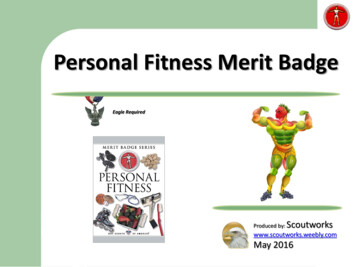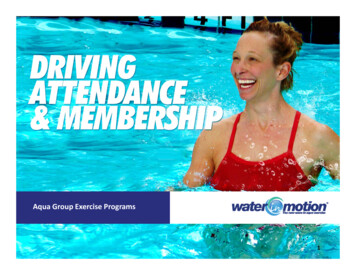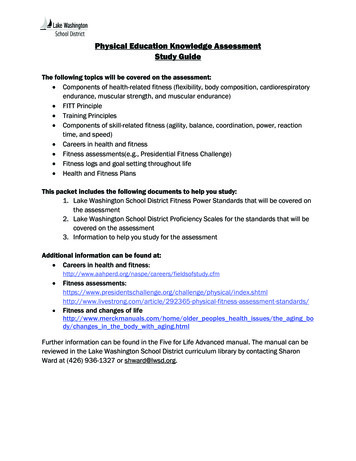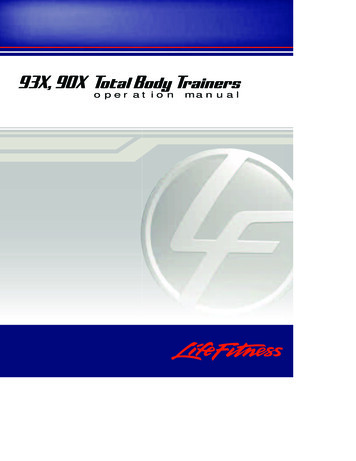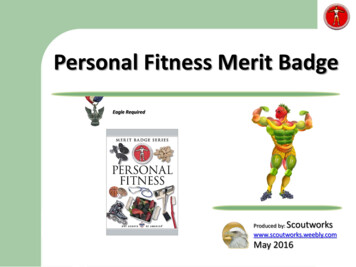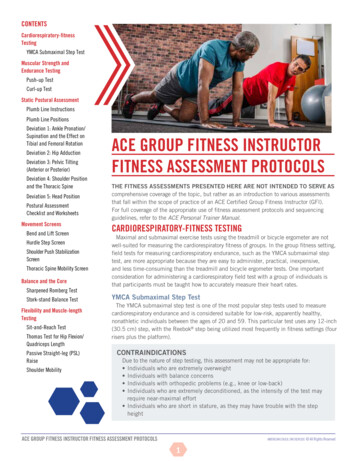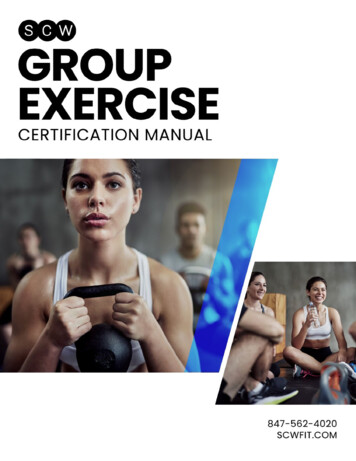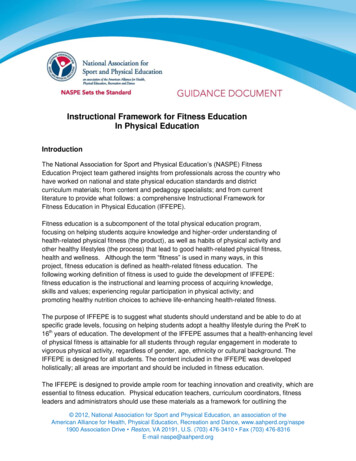
Transcription
Instructional Framework for Fitness EducationIn Physical EducationIntroductionThe National Association for Sport and Physical Education’s (NASPE) FitnessEducation Project team gathered insights from professionals across the country whohave worked on national and state physical education standards and districtcurriculum materials; from content and pedagogy specialists; and from currentliterature to provide what follows: a comprehensive Instructional Framework forFitness Education in Physical Education (IFFEPE).Fitness education is a subcomponent of the total physical education program,focusing on helping students acquire knowledge and higher-order understanding ofhealth-related physical fitness (the product), as well as habits of physical activity andother healthy lifestyles (the process) that lead to good health-related physical fitness,health and wellness. Although the term “fitness” is used in many ways, in thisproject, fitness education is defined as health-related fitness education. Thefollowing working definition of fitness is used to guide the development of IFFEPE:fitness education is the instructional and learning process of acquiring knowledge,skills and values; experiencing regular participation in physical activity; andpromoting healthy nutrition choices to achieve life-enhancing health-related fitness.The purpose of IFFEPE is to suggest what students should understand and be able to do atspecific grade levels, focusing on helping students adopt a healthy lifestyle during the PreK to16th years of education. The development of the IFFEPE assumes that a health-enhancing levelof physical fitness is attainable for all students through regular engagement in moderate tovigorous physical activity, regardless of gender, age, ethnicity or cultural background. TheIFFEPE is designed for all students. The content included in the IFFEPE was developedholistically; all areas are important and should be included in fitness education.The IFFEPE is designed to provide ample room for teaching innovation and creativity, which areessential to fitness education. Physical education teachers, curriculum coordinators, fitnessleaders and administrators should use these materials as a framework for outlining the 2012, National Association for Sport and Physical Education, an association of theAmerican Alliance for Health, Physical Education, Recreation and Dance, www.aahperd.org/naspe1900 Association Drive Reston, VA 20191, U.S. (703) 476-3410 Fax (703) 476-8316E-mail naspe@aahperd.org
2Instructional Framework for Fitness Education in PE (Cont.)desired outcomes of fitness education learning experiences. They are intended to provideguidance for customizing content to meet the needs of students from a state, local orprogrammatic level. It would be inaccurate to interpret the content of these materials as a rigid,standardized delivery of fitness education, because context, region, resources, facilities andstudent expectations differ.Overall, this proposed IFFEPE should be integrated into an existing physical educationcurriculum with full or partial lessons that address the identified fitness content at individualgrade levels. For example, an entire lesson can be dedicated to the concept of energy balance.Fitness education also can be integrated into sport-oriented lessons, in which — for purposes ofthis example — the focus is volleyball skill learning, but the students are simultaneously learninghow to improve muscle endurance by performing specific upper- and lower-body movementsrepeatedly. Measureable benchmarks represent the skills, knowledge and values reflective ofcompetence at a given point of time and can be used to develop curriculum or fitness-specificcourses, or just to confirm that appropriate domains are included in the current curriculum.Overall, fitness education should incorporate an updated, coherent and professionallydefensible scope and sequence of how fitness content should be organized for purposes ofinstruction and learning. Of more importance, fitness education must not be taught in isolationand should be embedded in the content taught in all units. The IFFEPE for PreK-16 programsprovides guidance for physical education teachers and other relevant professionals.In addition to creating a much-needed K-12 IFFEPE, this project adds PreK and collegebenchmarks to the curriculum framework, which will further refine the appropriate content ateach level of education. It is NASPE’s hope that this broader vision that starts earlier andcontinues through postsecondary education will help to foster physically active and fit citizens.The outline on the next two pages identifies the general domains and subdomains of contentaligned with NASPE’s National Standards. Following that is the Instructional Framework, whichidentifies each content domain and sub-domain down the left side of the chart, with theappropriate content for groups of grade levels across the columns. Project members chose thegrade-level grouping format to allow those using the framework some flexibility in the coverageof the identified content and to align with NASPE’s National Standards for Physical Education.A priority index (scale of 1-5, with 5 the highest) found on pp. 37-41 has been used to identifythe content that appeared with the greatest frequency in state standards and, thus, deserves acertain level of importance. The higher the priority index, the more energy that should bededicated to ensuring that the topic and its associated key concepts are well covered. Allstatements, however, indicate areas to be included. 2012, National Association for Sport and Physical Education, an association of theAmerican Alliance for Health, Physical Education, Recreation and Dance, www.aahperd.org/naspe1900 Association Drive Reston, VA 20191, U.S. (703) 476-3410 Fax (703) 476-8316E-mail naspe@aahperd.org
3Instructional Framework for Fitness Education in PE (Cont.)Instructional Framework for Fitness Education in Physical Education Overview(Parallel NASPE’s National Standards for Physical Education)Technique: Demonstrate competency in techniques needed to perform a variety of moderate tovigorous physical activities. Technique in developing cardiovascular fitness.Technique when developing muscle strength and endurance activities.Technique in developing flexibility.Safety techniques.Knowledge: Demonstrate understanding of fitness concepts, principles, strategies andindividual differences needed to participate and maintain a health-enhancing level of fitness. Benefits of physical activity/dangers of physical inactivity.Basic anatomy & physiology.Physiological responses to physical activity.Components of health-related fitness.Training principles (overload, specificity, progression) & workout elements.Application of FITT principle.Factors that influence physical activity choices.Physical Activity: Participate regularly in fitness-enhancing physical activity. Physical activity participation (e.g., aerobic, muscle strength & endurance, bonestrength, flexibility, enjoyment/social/personal meaning).Create an individualized physical activity plan.Self-monitor physical activity and adhere to a physical activity plan.Health-Related Fitness: Achieve and maintain a health-enhancing level of health-relatedfitness. Physical fitness assessment (including self-assessment) & analysis.Setting goals & create a fitness improvement plan.Work to improve fitness components.Self-monitor & adjust plan.Achieve goals.Responsible Personal and Social Behaviors: Exhibit responsible personal and socialbehaviors in physical activity settings. Social interaction/respecting differences.Self-management.Personal strategies to manage body weight.Stress management. 2012, National Association for Sport and Physical Education, an association of theAmerican Alliance for Health, Physical Education, Recreation and Dance, www.aahperd.org/naspe1900 Association Drive Reston, VA 20191, U.S. (703) 476-3410 Fax (703) 476-8316E-mail naspe@aahperd.org
4Instructional Framework for Fitness Education in PE (Cont.)Values & Advocates: Value fitness-enhancing physical activity for disease prevention,enjoyment, challenge, self-expression, self-efficacy and/or social interaction; andallocate energies toward the production of healthy environments. Value physical activity.Advocacy.Fitness careers.Occupational fitness needs.Nutrition: Strive to maintain healthy diet through knowledge, planning and regular monitoring. Basic nutrition and benefits of a healthy diet.Healthy diet recommendations.Diet assessment.Plan and maintain a healthy diet.Consumerism: Access and evaluate fitness information, facilities, products and services. Differentiate between fact and fiction regarding fitness products.Make good decisions about consumer products. 2012, National Association for Sport and Physical Education, an association of theAmerican Alliance for Health, Physical Education, Recreation and Dance, www.aahperd.org/naspe1900 Association Drive Reston, VA 20191, U.S. (703) 476-3410 Fax (703) 476-8316E-mail naspe@aahperd.org
5Instructional Framework for Fitness Education in Physical Education (Cont.)Instructional Framework for Fitness Education in Physical EducationTechnique: Demonstrates competency in techniques needed to perform a variety of moderate to vigorous physical activities.DescriptorPreK-KBenchmarkGrades 1-2BenchmarkGrades 3-5BenchmarkGrades 6-8BenchmarkGrades 9-12BenchmarkTechnique inimprovingcardiovascularfitness Demonstratebody controlwhen performingcardiovascularactivities. Demonstrategood bodyalignment andcontrol in variouscardiovascularactivities (e.g.,jogging, running,biking). Demonstrateappropriate form(e.g., arm swingforward andback) andprinciples (e.g.,pacing) incardiovascularactivities. Apply theappropriateform, speed &generation offorce duringcardiovascularactivities. Apply rates ofperceivedexertion (RPE) &pacing. Adjust pacing tokeep HR in thetarget zone. Adjust pacing tokeep HR in thetarget zone. Adjust pacing tokeep HR in thetarget zone forextendedperiods of time. 2012, National Association for Sport and Physical Education, an association of theAmerican Alliance for Health, Physical Education, Recreation and Dance, www.aahperd.org/naspe1900 Association Drive Reston, VA 20191, U.S. (703) 476-3410 Fax (703) 476-8316E-mail naspe@aahperd.orgHigherEducationBenchmark
6Instructional Framework for Fitness Education in Physical Education (Cont.)DescriptorPreK-KBenchmarkGrades 1-2BenchmarkGrades 3-5BenchmarkGrades 6-8BenchmarkGrades 9-12BenchmarkTechnique whenimprovingmuscle strength& endurance Perform bodyweight activities(e.g., bear crawl,crab walk). Perform musclestrengtheningand enduranceexercise (e.g.,lifting sand bags,jumping, hopping) mechanically correctly. Demonstrateappropriate formwhen performingresistanceactivities (e.g.,push-ups,crunches). Analyze anddifferentiatebasicmusculoskeletaltechniques (e.g.,alignment, kneenot in front offoot) necessaryto participatesafely in selected movementforms (e.g., correct musculoskeletal errorswhile performingstretching, yoga,modified weightlifting, etc.). Apply basicmusculoskeletaltechniquesnecessary toparticipate instrength andenduranceactivities. Demonstrateability to useown body asresistance todevelop strength& endurance(e.g., hold bodyin plank positionwith bodystraight, animalwalks). Demonstrateability to stabilizethe core whenperformingmusclestrengthening &enduranceactivities. Demonstrateappropriatetechnique inresistancetrainingmachines & freeweights (e.g.,sand bells, bars,bands, homemade jugweights). Demonstrateproper machineadjustment andtechniques onresistancetrainingmachines, andcompare machines to freeweight lifting, 2012, National Association for Sport and Physical Education, an association of theAmerican Alliance for Health, Physical Education, Recreation and Dance, www.aahperd.org/naspe1900 Association Drive Reston, VA 20191, U.S. (703) 476-3410 Fax (703) 476-8316E-mail naspe@aahperd.orgHigherEducationBenchmark
7Instructional Framework for Fitness Education in Physical Education (Cont.)DescriptorPreK –KBenchmarkGrades 1-2BenchmarkGrades 3-5BenchmarkGrades 6-8BenchmarkGrades 9-12BenchmarkTechnique whenimprovingflexibility Demonstratebasic stretchingtechniques. Demonstrateappropriatetechnique whenstretching majormuscle groups,showing properalignment andstretchingwithout bouncingor hyperextending joints. Demonstrateappropriatetechnique whenstretching (e.g.,avoid hyperextension ofknees, knee infront of foot,back flexion,back hyperextension,pulling on neck,pulling on toes[vs. ankles]when quadstretching, stresson medial kneeligaments). Demonstratecorrecttechniques andmethods ofstretching (e.g.,alignment, nohyperextension). Demonstrateproper alignmentwhile stretching. Know to performstretching onlyafter musclesare warm. Apply understanding thatstretching is todevelop andmaintain rangeof motion and isbest done at theend of activitytime. Demonstrate thedifference between dynamicflexibility andstatic flexibilityand when totarget each in aworkout. Demonstratevariety ofappropriatestretchingtechniques(static, PNF,active isolatedand passive). 2012, National Association for Sport and Physical Education, an association of theAmerican Alliance for Health, Physical Education, Recreation and Dance, www.aahperd.org/naspe1900 Association Drive Reston, VA 20191, U.S. (703) 476-3410 Fax (703) 476-8316E-mail naspe@aahperd.orgHigherEducationBenchmark
8Instructional Framework for Fitness Education in Physical Education (Cont.)DescriptorPreK-KBenchmarkGrades 1-2BenchmarkGrades 3-5BenchmarkGrades 6-8BenchmarkGrades 9-12BenchmarkSafetytechniques Followdirections, useequipmentproperly andmove safely inschool &community Apply safetystrategies,including usinggood bodycontrol, followingsafety signs andusing equipmentappropriately. Adjust effort toensure safe playand useequipmentappropriately. Demonstrateappropriateetiquette, care ofequipment andrespect forfacilities, andexhibit safebehaviors. Hold oneself andothersresponsible forfollowing safetypractices. Identify safe &unsafe places toplay, such as abackyard &street. Anticipatepotentiallydangerousconsequences ofparticipating inactivities andcontribute to thedevelopmentand maintenance of rulesand equipmentuse that providefor safeparticipation inphysicalactivities. 2012, National Association for Sport and Physical Education, an association of theAmerican Alliance for Health, Physical Education, Recreation and Dance, www.aahperd.org/naspe1900 Association Drive Reston, VA 20191, U.S. (703) 476-3410 Fax (703) 476-8316E-mail naspe@aahperd.orgHigherEducationBenchmark
9Instructional Framework for Fitness Education in Physical Education (Cont.)DescriptorPreK-KBenchmarkGrades 1-2BenchmarkGrades 3-5BenchmarkGrades 6-8BenchmarkGrades 9-12Benchmark Wearappropriateclothing. Wearappropriateclothing, useprotectiveequipment andprotect the bodyfrom weatherconditions. Wearappropriateclothing fordifferent weatherconditions. Apply strategiesfor protectionfrom cold, heatand sun duringactivity, includinghydration andsunscreen. Differentiateamong the threetypes of heatillnessesassociated withfluid loss (heatcramps, heatexhaustion andheat stroke) andtheir symptoms.Also, identify theappropriateprevention andfirst aidresponses. Recognize signsof exhaustion. Identify issueswhen exercisingin the cold (e.g.,frostbite,hypothermia)and theappropriateprevention andfirst aidresponses. 2012, National Association for Sport and Physical Education, an association of theAmerican Alliance for Health, Physical Education, Recreation and Dance, www.aahperd.org/naspe1900 Association Drive Reston, VA 20191, U.S. (703) 476-3410 Fax (703) 476-8316E-mail naspe@aahperd.orgHigherEducationBenchmark
10Instructional Framework for Fitness Education in Physical Education (Cont.)DescriptorPreK-KBenchmarkGrades 1-2BenchmarkGrades 3-5BenchmarkGrades 6-8BenchmarkGrades 9-12Benchmark Understand theeffects ofasthma onbreathing. Know thesymptoms ofasthma andhelpful ways toreact. Know strategiesfor preventingand reducingasthmasymptoms. Know strategiesfor dealing withsevere asthmaattacks. Identifyemergencysituations andhow to call 911. Identifyemergencysituations (e.g.,personcollapses) andhow to get help(e.g., find anadult, call 911). Identifyemergencysituations (e.g.,personcollapses) andhow to get help(e.g., find anadult, call 911). Identifyemergencysituations (e.g.,choking, drowning) and safemethods ofresponding tothem (cardiopulmonaryresuscitation[CPR] anduniversalprecautions). Obtaincertifications forfirst aid, CPRand automatedexternaldefibrillator(AED). Understand howto access schoolresources duringan emergency. Understand howto accesscommunityresources duringan emergency. 2012, National Association for Sport and Physical Education, an association of theAmerican Alliance for Health, Physical Education, Recreation and Dance, www.aahperd.org/naspe1900 Association Drive Reston, VA 20191, U.S. (703) 476-3410 Fax (703) 476-8316E-mail naspe@aahperd.orgHigherEducationBenchmark
11Instructional Framework for Fitness Education in Physical Education (Cont.)Knowledge: Demonstrates understanding of fitness concepts, principles, strategies and individual differences needed to participateand maintain a health-enhancing level of physical fitness.DescriptorPreK-KBenchmarkGrades 1-2BenchmarkBenefits ofphysicalactivity/dangersof physicalinactivity Understand thatthe body andbrain needphysical activityfor optimalfunctioning. Discuss benefitsof being activeand having astrong body(e.g., goodposture,endurance,injuryprevention, forcegeneration, morecapable in play).Grades 3-5Benchmark Identify theimpact ofregular physicalactivity onphysical health(e.g., healthyweight,stronger heart,enhancedmuscle strength& endurance,strong bones,healthy lungs,sick less often).Grades 6-8Benchmark Analyze theempoweringconsequencesof beingphysically fit(e.g., improvedcognition,stamina,confidence).Grades 9-12Benchmark Compare &contrast thehealth-relatedbenefits ofvarious physicalactivities (e.g.,improvedcognition,increasedstrength tion). Explain theinterrelationshipof physicalactivity tophysiologicalresponses andphysical, mental/intellectual,emotional andsocial benefits. 2012, National Association for Sport and Physical Education, an association of theAmerican Alliance for Health, Physical Education, Recreation and Dance, www.aahperd.org/naspe1900 Association Drive Reston, VA 20191, U.S. (703) 476-3410 Fax (703) 476-8316E-mail naspe@aahperd.orgHigherEducationBenchmark Discuss thepsychologicalfactorsinfluenced byregular physicalactivity (e.g.,stress reduction,improved mood).
12Instructional Framework for Fitness Education in Physical Education (Cont.)DescriptorPreK-KBenchmarkGrades 1-2BenchmarkGrades 3-5BenchmarkGrades 6-8BenchmarkGrades 9-12Benchmark Identify thebenefits ofinvolvement indaily physicalactivity (e.g.,feeling better,sleeping better). Describe howphysical activityimproves sleepand how sleephelps the bodybe healthy. Identify personalpsychologicaland socialbenefits gainedfrom participating in regularphysical activity(e.g., improvedself-esteem,better sleep,improved abilityto focus andconcentrate). Recognizephysical activityas a positiveopportunity forstress reductionand socialinteraction. Analyze thebenefits of ahealthy lifestyleand the consequences of poornutrition andinactivity. Identify positivefeelings fromparticipatingregularly inphysical activity. Identify positivemental andemotionalaspects ofparticipating in avariety ofphysicalactivities. 2012, National Association for Sport and Physical Education, an association of theAmerican Alliance for Health, Physical Education, Recreation and Dance, www.aahperd.org/naspe1900 Association Drive Reston, VA 20191, U.S. (703) 476-3410 Fax (703) 476-8316E-mail naspe@aahperd.orgHigherEducationBenchmark Analyze possiblelife differencesbetween unfitand fitindividuals atdifferent times inthe lifespan.
13Instructional Framework for Fitness Education in Physical Education (Cont.)DescriptorPreK-KBenchmarkGrades 1-2BenchmarkGrades 3-5BenchmarkGrades 6-8BenchmarkGrades 9-12BenchmarkBasic anatomy &physiology Locate the heartand relate that itpumps bloodthroughout thebody. Describe thebasic features(e.g., size,location,function) of theheart and lungs. Explain the roleof the lungs inproviding O2 tothe blood andcollecting CO2from the blood. Explain andlabel body systems that interact with eachother (e.g., theblood transporting nutrientsfrom the digestive system). Predict theimpact ofphysical activityon thefunctioning ofbody systems. Identify majormuscle groups. Understand whatmajor musclesare used in basicexercises. Analyze musclesthat are involvedin certainstrength &enduranceexercises. Discuss the importance of balancing thedevelopment ofstrength in opposing musclegroups. Analyze thedifferencesamongconcentric,eccentric andisometric musclecontraction. Apply the concepts of concentric, eccentricand isometriccontraction tothe use of majormuscles in basicfitness activities. Describe howmuscles pull onbones to createmovement andhow muscleswork in pairs byrelaxing andcontracting. 2012, National Association for Sport and Physical Education, an association of theAmerican Alliance for Health, Physical Education, Recreation and Dance, www.aahperd.org/naspe1900 Association Drive Reston, VA 20191, U.S. (703) 476-3410 Fax (703) 476-8316E-mail naspe@aahperd.orgHigherEducationBenchmark
14Instructional Framework for Fitness Education in Physical Education (Cont.)DescriptorPreK-KBenchmarkBasic anatomy &physiologyDescriptorPhysiologicalresponses tophysical activity Recognize thatwhen you movefast, your heartbeats fasterand youbreathe faster.Grades 1-2BenchmarkGrades 3-5BenchmarkGrades 6-8BenchmarkGrades 9-12Benchmark Explain thebenefits of goodposture. Understand howto maintain goodposture, and therelationshipamong organhealth, corestability andgood posture. Evaluatestrategies formaintaininggood posture. Analyze one’spersonal postureand identifyneeds forimprovement. Identify thephysiologicalsigns ofmoderate tovigorousphysical activity,such asincreased heartrate, fasterbreathing,sweating andincreased bodytemperature. Define restingheart rate (RHR)and understandits relationship tothe level ofaerobicendurance. Identify thechanges inphysiologicaleffects ofphysical activityon the body(e.g., increasedsweating, bodyodor) as oneenters puberty. Analyze thelong-term effectsof regularparticipation inmoderate tovigorousphysical activityon the bodysystems ). 2012, National Association for Sport and Physical Education, an association of theAmerican Alliance for Health, Physical Education, Recreation and Dance, www.aahperd.org/naspe1900 Association Drive Reston, VA 20191, U.S. (703) 476-3410 Fax (703) 476-8316E-mail naspe@aahperd.orgHigherEducationBenchmark Describe howphysiologicalchangesstemming fromphysical activityaffect social,emotional andpsychologicalwell-beingamong adults.
15Instructional Framework for Fitness Education in Physical Education (Cont.)DescriptorPhysiologicalresponses tophysical activityPreK-KBenchmarkGrades 1-2BenchmarkGrades 3-5Benchmark Understand thatspecific bodyresponses tophysical activityare related toindividual levelsof fitness.Grades 6-8Benchmark Understand thatphysiologicalresponses tophysical activityare associatedwith one's levelof physicalfitness andnutritionalbalance.Grades 9-12Benchmark Identify personalphysiologicalresponses tophysical activity. Understand howand why adultpatterns ofphysical activityparticipationchangethroughout life(i.e., identify theeffects of age onthe physiologicalresponse tophysical activity). 2012, National Association for Sport and Physical Education, an association of theAmerican Alliance for Health, Physical Education, Recreation and Dance, www.aahperd.org/naspe1900 Association Drive Reston, VA 20191, U.S. (703) 476-3410 Fax (703) 476-8316E-mail naspe@aahperd.orgHigherEducationBenchmark
16Instructional Framework for Fitness Education in Physical Education (Cont.)DescriptorPreK-KBenchmarkGrades 1-2BenchmarkPhysiologicalresponses tophysical activityGrades 3-5BenchmarkGrades 6-8BenchmarkGrades 9-12Benchmark Distinguishbetween aerobicand anaerobicactivities. Compare andcontrast aerobicversus anaerobic activities,and be able todistinguishbetween the twoand provideexamples ofeach. Understand theenergy formsused in aerobicand anaerobicactivities. Identifyactivities thatone can use todevelop each ofthe fivecomponents ofhealth-relatedfitness. Compare andcontrast healthrelated fitnesscomponents(cardiovascularendurance,muscle strength,muscle endurance, flexibilityand bodycomposition). Explain howeach of thehealth-relatedfitness components is improvedthrough the application oftrainingprinciples. Distinguishbetween healthrelated & skillrelated fitness. Compare andcontrast skillrelated fitnesswith healthrelated ts ofhealth-relatedfitness Describe inbasic terms thatthere aredifferent ways tobe fit (heart &lungs, muscles,ratio of lean tofat). Identify the fivehealth-relatedcomponents uscleendurance,flexibility andbodycomposition). 2012, National Association for Sport and Physical Education, an association of theAmerican Alliance for Health, Physical Education, Recreation and Dance, www.aahperd.org/naspe1900 Association Drive Reston, VA 20191, U.S. (703) 476-3410 Fax (703) 476-8316E-mail naspe@aahperd.org Identify personalpreferences forways to improvethe fivecomponentsusingappropriateapplications oftrainingprinciples.
17Instructional Framework for Fitness Education in Physical Education nsity, time,type, overload,specificity,progression) &workoutelementsPreK-KBenchmarkGrades 1-2BenchmarkGrades 3-5BenchmarkGrades 6-8Benchmark Classifyactivities into“light, medium &hard” worklevels. Identify theterms“frequency,”“intensity,” “time”& “type,” anduse them indescribing aphysical activity. Describe theFITT Principleand trainingprinciples(frequency,intensity, time,type, overload,progression,specificity), andhow they affectphysical fitness. Define basicexerciseterminology,such as“repetition” and“set.” Use the FITTPrinciple(frequency,intensity, timeand type) andtrainingprinciples thataffect physicalfitness (e.g.,overload,specificity,progression) indescribing apersonalworkout.Grades 9-12Benchmark Apply tofrequency,intensity, timeand type toyour workout. Employ anaccurate workingvocabularyrelated to fitnessand wellness. 2012, National Association for Sport and Physical Education, an association of theAmerican Alliance for Health, Physical Education, Recreation and Dance, www.aahperd.org/naspe1900 Association Drive Reston, VA 20191, U.S. (703) 476-3410 Fax (703) 476-8316E-mail naspe@aahperd.orgHigherEducationBenchmark
18Instructional Framework for Fitness Education in Physical Education nsity, time,type, overload,specificity,progression) &workoutelementsPreK-KBenchmarkGrades 1-2BenchmarkGrades 3-5BenchmarkGrades 6-8BenchmarkGrades 9-12Benchmark Distinguishamong the threeparts of aworkout (warmup, workout,cool-down). Self-initiatewarm-up andcool-downduring activitytimes. Use availabletechnology toanalyze heartrate andrecovery time;distinguishamong the threeparts of aworkout (warmup, workout,cool-down) on aheart rate graph. 2012, National Association for Sport and Physical Education, an association of theAmerican Alliance for Health, Physical Education, Recreation and Dance, www.aahperd.org/naspe1900 Association Drive Reston, VA 20191, U.S. (703) 476-3410 Fax (703) 476-8316E-mail naspe@aahperd.orgHigherEducationBenchmark
19Instructional Framework for Fitness Education in Physical Education (Cont.)DescriptorPreK-KBenchmarkGrades 1-2BenchmarkGrades 3-5BenchmarkGrades 6-8BenchmarkGrades 9-12BenchmarkFactors thatinfluencephysical activitychoices Identify physicalactivities that areenjoyable. Describephysical activitypreferences. Analyzepersonalphysical activitypreferences. Analyze the roleof individualattitude, motivation and selfdetermination inselecting fitnessactivities. Describeappropriatestrategies tosupport fitnesshabits on apersonal level. Analyzepreferences andchange activitiesin ways thatmake them moreenjoyable. Compare &contrastpersonalcharacteristicsand activitypreferences,includingchanges overthe lifespan. Describe howenvironment,lifestyle, familyhistory, peersand other factorsaffect physical,social, mentaland emotionalhealth. Analyze factorsthat influencenutritional andfitness choices,including peers,family and bodyimage. Identify waysthat familyinfluencesfitness &fitnessdecisions. Describe howfamily & friendsinfluence fitnessbehaviors. Explainimmediate &long-termimpacts offitness decisionsto the individual,family andcommunity. 2012, National Association for Sport and Physical Education, an association of theAmerican Alliance for Health, Physical Education, Recreation and Dance, www.aahperd.org/naspe1900 Association Drive Reston, VA 20191, U.S. (703) 476-3410 Fax (703) 476-8316E-mail naspe@aahperd.orgHigherEducationBenchmark Analyze whatfactors can bealtered throughinterventions. Evaluatemethods ofchanging healthrelated fitnessfactors.
20Instructional Framework for Fitness Education in Physical Education (Cont.)DescriptorPreK-KBenchmark Identify “screentime” activities(TV andcomputer use)and how theydiffer fromphysicalactivities.Grades 1-2BenchmarkGrades 3-5BenchmarkGrades 6-8BenchmarkGrades 9-12Benchmark Describeenvironmental,community &cultural factorsthat influencefitnessbehavi
Values & Advocates: Value fitness-enhancing physical activity for disease prevention, enjoyment, challenge, self-expression, self-efficacy and/or social interaction; and allocate energies toward the production of healthy environments. Value physical activity. Advocacy. Fitness caree



